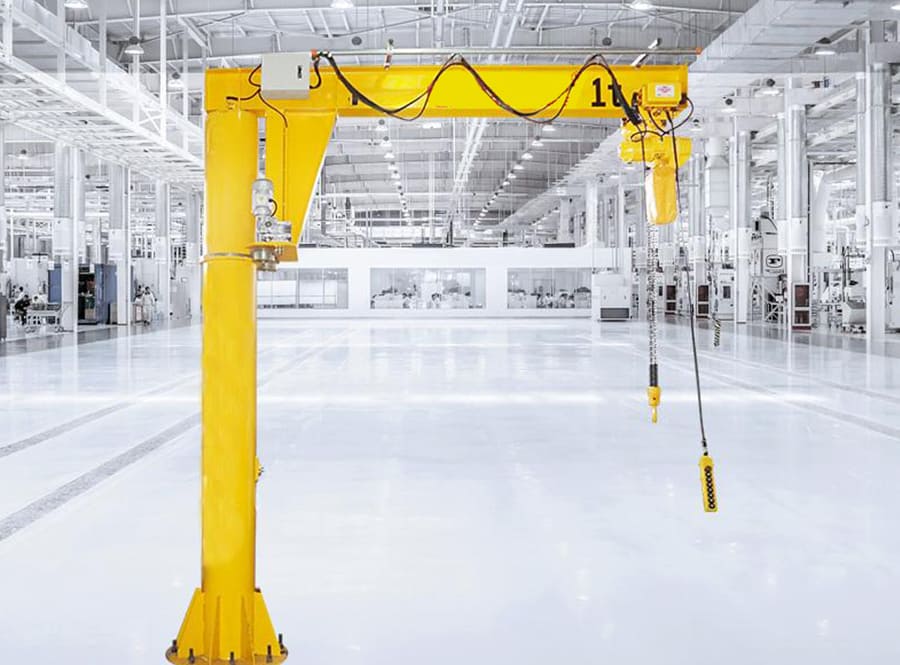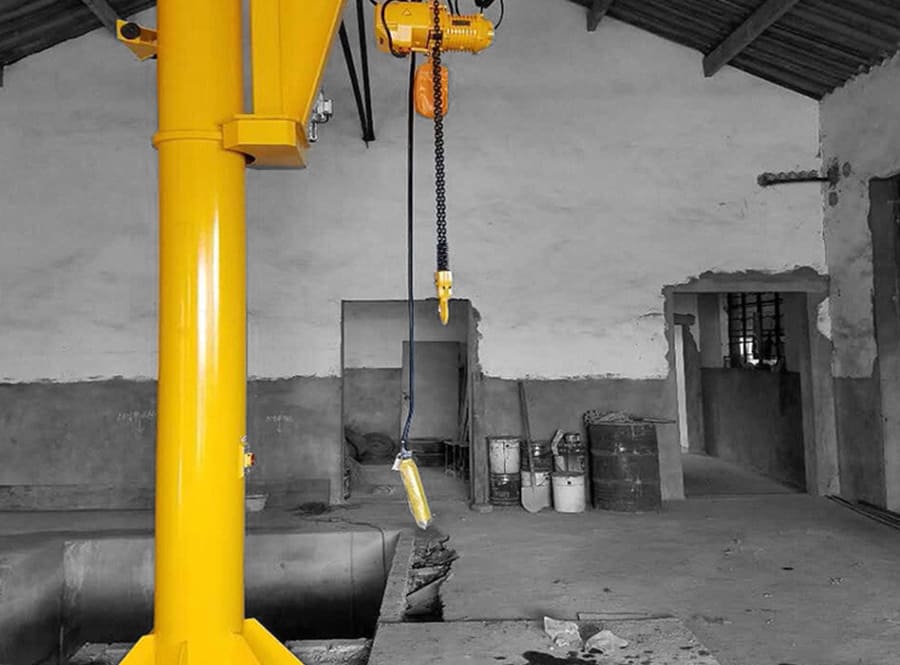Guindastes de lança são um tipo de equipamento de elevação amplamente utilizado em indústrias que exigem soluções de manuseio de materiais eficientes e flexíveis. Com seu design e versatilidade exclusivos, os guindastes de lança fornecem manobrabilidade aprimorada e facilidade de operação. Este artigo explorará os recursos, vantagens e aplicações dos guindastes de lança.
Recursos e Design:
Um guindaste de lança consiste em um mastro vertical ou pilar que suporta uma lança horizontal, também conhecida como braço de lança. O braço de lança pode girar até 360 graus, permitindo cobertura total dentro de seu raio de trabalho. Na extremidade do braço de lança, um mecanismo de elevação ou elevação é montado, permitindo que o guindaste levante e mova objetos pesados com facilidade. Os guindastes de lança vêm em várias configurações, como autônomos, montados na parede ou no teto, dependendo dos requisitos específicos da aplicação.

Vantagens dos guindastes de lança:
Flexibilidade e Manobrabilidade: Guindastes de lança oferecem excelente flexibilidade e manobrabilidade, tornando-os adequados para ambientes com espaço limitado. Sua capacidade de girar e alcançar diferentes áreas dentro de seu raio de trabalho garante manuseio eficiente de materiais em áreas que podem ser desafiadoras de acessar com outros tipos de guindastes.
Fácil instalação: Guindastes de lança são relativamente fáceis de instalar em comparação a guindastes de ponte rolante maiores. Eles exigem modificações mínimas na estrutura existente, e alguns modelos podem ser parafusados diretamente no chão ou na parede, minimizando o tempo de inatividade durante a instalação.
Posicionamento Preciso da Carga: Guindastes de lança fornecem posicionamento preciso da carga, graças à sua capacidade de girar e estender o braço da lança. Os operadores podem facilmente posicionar a carga com precisão, reduzindo o risco de danos ou acidentes durante o levantamento e a movimentação.
Solução de Custo-Efetivo: Guindastes de lança são uma solução de elevação de custo-efetivo, especialmente para tarefas de elevação leves a médias. Eles oferecem um investimento inicial menor em comparação com guindastes de ponte rolante maiores, tornando-os uma opção atraente para pequenas e médias empresas.

Aplicações de Guindastes de Lança:
Instalações de Fabricação e Produção: Guindastes de lança são comumente usados em instalações de fabricação e produção para elevação e movimentação de materiais, componentes e produtos acabados ao longo de linhas de montagem. Eles são particularmente úteis em estações de trabalho onde tarefas repetitivas de elevação são necessárias.
Armazéns e Centros de Distribuição: Guindastes de lança são empregados em armazéns e centros de distribuição para carregar e descarregar mercadorias de contêineres, caminhões e prateleiras. Eles facilitam o manuseio eficiente de materiais, reduzindo o trabalho manual e aumentando a produtividade.
Canteiros de obras: Guindastes de lança são utilizados em canteiros de obras para içar materiais de construção pesados, como vigas de aço, painéis de concreto pré-moldado e maquinário. Seu design compacto e manobrabilidade os tornam adequados para navegar em áreas de construção apertadas ou congestionadas.
Instalações automotivas e de manutenção: guindastes de lança são comumente encontrados em oficinas automotivas e instalações de manutenção para elevar e posicionar motores, transmissões e outros componentes automotivos pesados durante tarefas de reparo e manutenção.
Conclusão:
Guindastes de lança oferecem uma solução de elevação versátil e eficiente em vários setores. Sua flexibilidade, manobrabilidade e facilidade de instalação os tornam ideais para ambientes com espaço limitado. Seja na fabricação, armazéns, canteiros de obras ou instalações automotivas, os guindastes de lança fornecem posicionamento preciso de carga e aprimoram as operações de manuseio de materiais. Com sua relação custo-benefício e design prático, os guindastes de lança continuam sendo um ativo valioso para empresas que buscam otimizar seus processos de elevação e manuseio.
